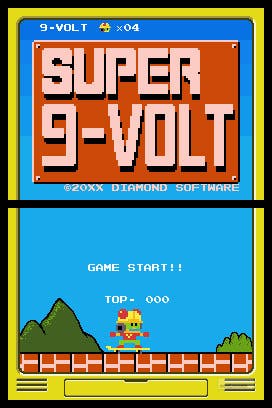WarioWare DIY
Build!
Creating the background drops you into a fairly standard art package. You can draw, flood areas, switch colours or writing implements, clone objects, and even select from a suitably bizarre range of clipart. For the tutorial game – I think it was called Ladybird: Combat Evolved - all that was required was hunting down some grass texturing, making it green, and them spamming rocks all over the place. Done.
Next up comes the object stage: another art editor, very similar to the first, but with the option to create four frames of animation for each drawing. The ladybird came to life through a mixture of shape tools and freehand sketching, and it was fairly easy to layer it into a second cell as a transparency, and then redraw it - I'm about to use a very technical animation term - basically the same, but shifted a little bit to the left. Two frames of animation were all it took to turn a bad drawing of a ladybird into a bad drawing of a ladybird that sort of appeared to be moving if you squinted and were feeling charitable. Two steps in and Ladybird: Hell's Highway was coming into focus.

The soundtrack section swaps out the art editor for a sequencer. Dropping notes into each beat slot is a simple business, with plenty of room to change the pitch after the fact, and there are multiple tracks to layer in alongside a separate rhythm bed. There's a range of instruments to choose from, too, and even a "hum mode" which allows you to use the microphone to make your songs sound even worse. My song sounded pretty terrible already, thankfully, so it was on to the next step. With a rousing theme tune, Ladybird: Extreme Condition was.. sorry, I'm going to stop doing this now.
AI's next, and unless you're a certain kind of person - the kind of person who keeps sheets of engineer's quadrille by the bed, often ponders why British people accept such basic offerings when it comes to light switches, and never wanders into town without at least five different screwdrivers attached to your keyring - you're probably not going to get that much of a kick out of this stage all by itself. Having drawn the art and created the horrible, horrible soundtrack, it was time to pull the pieces together.
To do this, Nintendo has essentially created a very bare-bones programming language. Thankfully, it's based around actual sentences rather than strange mathematical symbols which only people who earn £100,000 or more a year understand. The core of the system - although you can finesse it far more than you might expect - is creating variations on the sentence: "If A happens, do B." That one got me through my first marriage. (Thoughts to the family.)


